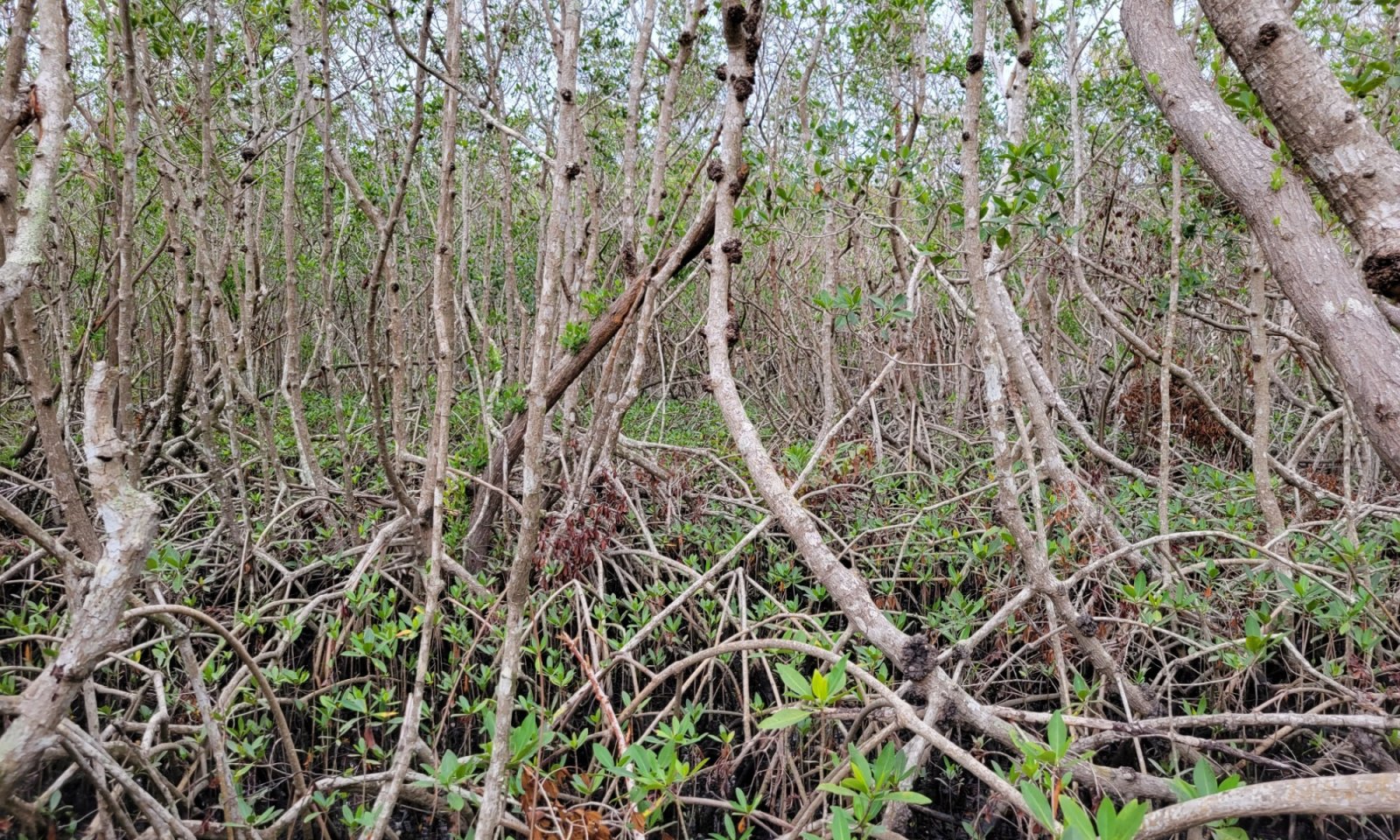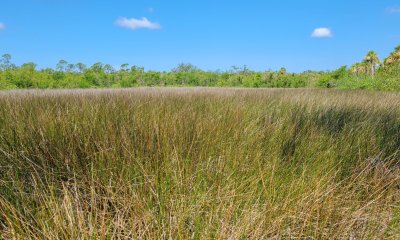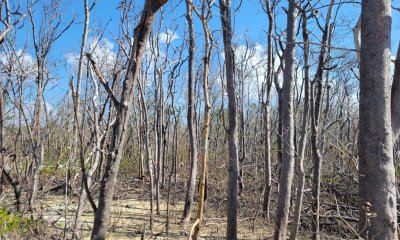
Haline Intertidal Marshes and Swamps
Scenario model
Current ecosystem state
Select a state
Management practices/drivers
Select a transition or restoration pathway
-
Transition T1A
Large Scale Disturbance Events
More details -
Transition T1B
Introduction and Establishment of Noxious Non-Native or Undesirable Invasive Plant Species
More details -
Transition T1C
Human Alteration / Transportation of Soils Material
More details -
Transition T2A
Mangrove Establishment
More details -
Transition T2B
Large Scale Disturbance Events
More details -
Transition T2C
Introduction and Establishment of Noxious Non-Native or Undesirable Invasive Plant Species
More details -
Transition T2D
Human Alteration / Transportation of Soils Material
More details -
Transition T2E
Increase in Long Term Hydroperiod
More details -
Restoration pathway R3A
Remediation, Seedbank Establishment/ Propagation
More details -
Restoration pathway R3B
Remediation, Seedbank Establishment/ Propagation
More details -
Transition T3A
Increase in Long Term Hydroperiod
More details -
Restoration pathway R4A
Removal of Undesirable Species
More details -
Restoration pathway R4B
Removal of Undesirable Species
More details -
Restoration pathway R5A
Living Shoreline Restoration
More details -
Restoration pathway R5B
Living Shoreline Restoration
More details -
No transition or restoration pathway between the selected states has been described
Target ecosystem state
Select a state
Description
These are dense forests occurring along relatively flat, low-wave energy, marine and estuarine shorelines.
Submodel
Description
These are largely herbaceous communities that occurs in the portion of the coastal zone affected by tides and seawater and protected from large waves, either by the broad, gently sloping topography of the shore, by a barrier island, or by location along a bay or estuary.
Submodel
Description
This state serves as the foundation for the development of other subaqueous and intertidal natural communities when conditions become appropriate. This is a highly fluctuating community and is altered by storm events and can originate from organic sources, such as decaying plant tissues (e.g., mud) or from calcium carbonate depositions of plants or animals (e.g., coralgal, marl and shell substrates).
Submodel
Description
This state represents the dominance of one or multiple non-native or exotic species which outcompetes the native natural community and may significantly alter the composition and structure of the invaded stand by overshading the canopy and understory components and preventing regeneration of forest species.
Submodel
Description
These areas include soils that were intentionally and substantially modified by humans for an intended purpose, commonly for building support, transportation, and commerce. The alteration is of sufficient magnitude to result in the introduction of a new parent material (human-transported material) or a profound change in the previously existing parent material (human-altered material). They do not include soils modified or farmed with unintended wind and water erosion. When a soil is on or above an anthropogenic landform or microfeature, it can be definitely be associated with human activity and is assigned to a unique taxon, usually found as an "Urban land complex" within that communities' natural soil properties (e.g, Wulfert muck, tidal-Urban land complex, 0 to 1 percent slopes).
Characteristics and indicators
Evidence of these areas include soils with manufactured items (e.g. artifacts) present in the profile, human altered-materials (e.g., deeply excavated soil) or human-transported material (e.g., fill), and position on or above anthropogenic landforms (e.g., flood-control levees) and microfeatures (e.g., drainage ditches). Detailed criteria regarding the identification of anthropogenic (artificial) landforms, human-altered materials, and human-transported material are in the "Keys to Soil Taxonomy" (Soil Survey Staff, 2014).
Submodel
Description
This state describes the impact of increased hydroperiods from anthropogenic or natural causes that creates an altered hydrologic state resulting in permanent flooding. The impact of this causes destruction of the intertidal community and may in time shift to a subaqueous community.
Mechanism
This transition is driven by a large scale disturbance event which may shift the woody forest to either a ghost forest of standing dead wood or an area of unconsolidated substrates. A relatively low energy disturbance event, such as sea-level rise or creation of artificial impoundments, may extend the hydroperiod and will permanently saturate the root system and become too saline for the species tolerance. As this occurs, remaining mangrove species may encroach further inland, often at the expense of other ecological communities. Whereas a relatively high energy disturbance event, such as a hurricane or tropical storm, a freeze event, mosquito ditching, herbicides, etc. the naturalized communities may be destroyed, creating an area of unconsolidated substrates which will remain in an unvegetated state until a seedbank (either woody species or herbaceous species) becomes established and propagates. This transition may be a rapid shift from a woody forest to unconsolidated species to a herbaceous wetland or vice versa, dependent on the seedbank present and disturbance intensity to the sediment.
Mechanism
This transition represents proliferation and dominance of an invasive species. Soil mechanical disturbances can compound this effect and create suitable conditions for invasive species.
Mechanism
This transition is driven by the alteration and/ or transportation of soil materials via anthropogenic means. In these sites, it is often done to provide shoreline protection by replacing the native communities with a seawall or other shoreline protection strategies (Riprap, jetties, seawalls, etc.) to protect inland infrastructure.
Mechanism
This transition is driven by mangrove encroachment into a herbaceous wetland, replacing the dense understory of grasses with a mangrove forest. Salt marsh vegetation cannot grow in the shade of mangrove trees and will often degrade and become replaced. This is considered a transition rather than a restoration pathway as mangrove forests and herbaceous wetlands are two naturalized states, with unmeasurable slight variations in hydrologic regimes, elevation, and soil salinity being the main drivers for compositional and structural changes. An encroaching mangrove forest is often the result of and change in shoreline elevation, with the seaward edge of a mangrove forest slowly succumbing to an open water habitat while the landward edge migrates inland, at the expense of a herbaceous wetland. Absence of freeze events may also allow for the encroachment of mangroves into salt marsh habitats.
Mechanism
This transition is driven by a large scale disturbance event which may shift the herbaceous wetland into an area of unconsolidated substrates. A relatively low energy disturbance event, such as sea-level rise or creation of artificial impoundments, may extend the hydroperiod and will permanently saturate the root system and become too saline for the species tolerance. As this occurs, remaining mangrove species may encroach further inland, often at the expense of other ecological communities. Whereas a relatively high-energy disturbance event, such as a hurricane or tropical storm, may deposit sediment that, once exposed to air, undergoes rapid acid sulfate dynamics, lowering the pH. This may create an area of unconsolidated substrates which will remain in an unvegetated state until the systems pH is stabilized and a seedbank (either woody species or herbaceous species) becomes established and propagates.
Mechanism
This transition represents proliferation and dominance of an invasive species. Soil mechanical disturbances can compound this effect and create suitable conditions for invasive species.
Mechanism
This transition is driven by the alteration and/ or transportation of soil materials via anthropogenic means. In these sites, it is often done to provide shoreline protection by replacing the native communities with a seawall or other shoreline protection strategies (Riprap, jetties, seawalls, etc.) to protect inland infrastructure.
Mechanism
This is driven by increased hydroperiods, both anthropogenic and natural, which causes long term flooding permanently altering the site.
Mechanism
This restoration is driven by remediation techniques to restore hydrologic flow of the area, which will reduce the volume of acidic water by diluting it with a larger volume of neutral water. This is often done naturally as a system recovers from a high energy natural disturbance event such as a hurricane or tropical storm or freeze event, or may be done anthropogenically from a man-made disturbance event such as filling in mosquito ditches. Natural recovery is often seen due to the high tidal buffering potential of a natural supply of alkaline agents (bicarbonates/ carbonates) and daily tides. Once the unconsolidated substrate recovers from a low pH to an acceptable level for vegetative growth, a seedbank of either herbaceous or woody species must be present to restore the natural community. If a seedbank is absent, recovery efforts such as replanting seedlings (mangrove propagules) can be done by local, state, federal, and/ or private entities.
Mechanism
This restoration is driven by remediation techniques to restore hydrologic flow of the area, which will reduce the volume of acidic water by diluting it with a larger volume of neutral water. This is often done naturally as a system recovers from a high energy natural disturbance event such as a hurricane or tropical storm or freeze event, or may be done anthropogenically from a man-made disturbance event such as filling in mosquito ditches. Natural recovery is often seen due to the high tidal buffering potential of a natural supply of alkaline agents (bicarbonates/ carbonates) and daily tides. Once the unconsolidated substrate recovers from a low pH to an acceptable level for vegetative growth, a seedbank of either herbaceous or woody species must be present to restore the natural community. If a seedbank is absent, recovery efforts such as replanting seedlings (salt marsh grass "plugs") can be done by local, state, federal, and/ or private entities.
Mechanism
This is driven by increased hydroperiods, both anthropogenic and natural, which causes long term flooding and permanently altering the state.
Mechanism
The establishment of, or a return to, natural habitat conditions following a previous invasive / non-native / undesirable species infestation may be possible in some areas. Successful actions will require relentless efforts that include removal of the species via chemical, mechanical, or biological means. In some extreme cases, restoration attempts could result in greater erosion and worsening of local conditions. Please consult with District and Soil Conservationists at local NRCS Field Offices for advice and guidance on land restoration attempts on invaded areas.
Mechanism
The establishment of, or a return to, natural habitat conditions following a previous invasive / non-native / undesirable species infestation may be possible in some areas. Successful actions will require relentless efforts that include removal of the species via chemical, mechanical, or biological means. In some extreme cases, restoration attempts could result in greater erosion and worsening of local conditions. Please consult with District and Soil Conservationists at local NRCS Field Offices for advice and guidance on land restoration attempts on invaded areas.
Mechanism
This restoration involves removing a man-made shoreline structures used for shoreline protection or other anthropogenic activities and restoring the native ecological community. Anthropogenic infrastructure must be completely removed and mineral soil materials representative of the natural communities must be replaced as well as planting mangrove propagules or salt marsh plugs. In low to moderated wave energy areas with gradual slopes, native plants can stabilize the shoreline with their roots. Faunal communities such as oyster reefs may be used at the base of the plant slope to provide a wave break, water filtration, and habitat for aquatic species. In sites with relatively steep slopes, the steepness may be broken or interrupted by installing terraces containing native plants, designed to prevent soil erosion and collect runoff. A hybrid of these restoration efforts may be used and should be depend on local conditions. Please consult your local NRCS office for more information regarding these practices.
Mechanism
This restoration involves removing a man-made shoreline structures used for shoreline protection or other anthropogenic activities and restoring the native ecological community. Anthropogenic infrastructure must be completely removed and mineral soil materials representative of the natural communities must be replaced as well as planting mangrove propagules or salt marsh plugs. In low to moderated wave energy areas with gradual slopes, native plants can stabilize the shoreline with their roots. Faunal communities such as oyster reefs may be used at the base of the plant slope to provide a wave break, water filtration, and habitat for aquatic species. In sites with relatively steep slopes, the steepness may be broken or interrupted by installing terraces containing native plants, designed to prevent soil erosion and collect runoff. A hybrid of these restoration efforts may be used and should be depend on local conditions. Please consult your local NRCS office for more information regarding these practices.
Model keys
Briefcase
Add ecological sites and Major Land Resource Areas to your briefcase by clicking on the briefcase (![]() ) icon wherever it occurs. Drag and drop items to reorder. Cookies are used to store briefcase items between browsing sessions. Because of this, the number of items that can be added to your briefcase is limited, and briefcase items added on one device and browser cannot be accessed from another device or browser. Users who do not wish to place cookies on their devices should not use the briefcase tool. Briefcase cookies serve no other purpose than described here and are deleted whenever browsing history is cleared.
) icon wherever it occurs. Drag and drop items to reorder. Cookies are used to store briefcase items between browsing sessions. Because of this, the number of items that can be added to your briefcase is limited, and briefcase items added on one device and browser cannot be accessed from another device or browser. Users who do not wish to place cookies on their devices should not use the briefcase tool. Briefcase cookies serve no other purpose than described here and are deleted whenever browsing history is cleared.
Ecological sites
Major Land Resource Areas
The Ecosystem Dynamics Interpretive Tool is an information system framework developed by the USDA-ARS Jornada Experimental Range, USDA Natural Resources Conservation Service, and New Mexico State University.




